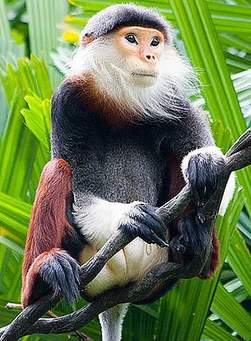
11 Nov TIO SE Asia: Danang & Hoi An & Saigon Chaser
A fisherman gets caught in a storm, but he is rescued by a magical turtle. The turtle gives the young man an egg, telling him that he to guard it well; one day he will know why. When that day comes, when the egg grows and grows and cracks open, the five pieces morph into the Marble or Five Elements Mountains. Enter a beautiful maiden. The boy and the girl fall in love and live happily – but not forever-after. Because the maiden was the turtle in human form and a turtle has to return to the sea. The fisherman finds himself alone again on the shore.
This version of how the mountains came into being is a Tru story – Tran Van Tru being the name of our guide in Danang and Hoi An, a gentleman and dedicated scholar.
“Danang.”
When I say the city’s name, you say…?
That likely depends on your age.
Boomers will remember that during the Vietnam War (1959–1975), Danang, the third largest city in Vietnam, was a major base for the U.S. military forces.
But that was then…
Now, well, the times they are a changin’… and quickly.
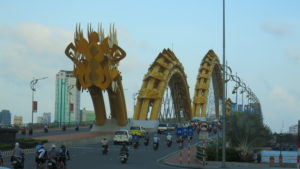
Dragon Bridge, Da Nang
The jumping-off point of the Son Tra Peninsula, the once-provincial backwater now boasts spectacular bridges across its major artery, the Han River, including one structure in the shape of a giant yellow dragon, which looks like it was made from giant Lego pieces.
Construction in general is booming: gleaming new apartment complexes and restaurants are popping up everywhere. The infamous China Beach – the beautiful 30km sweep of fine white sand that starts at Monkey Mountain and ends near Hoi An, once a playground for American soldiers on R & R – is now chockablock with new resorts and hotels.
None quite as fine as our digs, the incomparable hilltop resort, the Intercontinental Danang Sun Peninsula, officially Asia’s Leading Luxury Resort 2016.
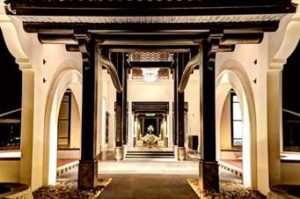
Entrance to Sun Peninsula, Monkey Mountain, Danang
The Intercontinental is located on Monkey Mountain – nicknamed by American soldiers during the war for its locals – a sprawling complex of rooms, suites, penthouses, and villas, overlooking a pristine, private bay and 700-meter beach; forested hills just beyond.
World-renowned, high-end resort architect, Harvard-educated and Bangkok-based Bill Bensley, wrote this eloquent story in black-and-white (with touches of Chinese red), reimagining the concept of Vietnamese design with a heavy emphasis on history and myth, executed with his signature whimsy. The retreat unfolds on four levels—Heaven, Sky, Earth, and Sea, each accessed by chauffeured golf buggies. (There is also a “Nam Tram,” an audacious, beautifully realized funicular car that takes guests from the beach up to the top of the resort to, well, Heaven.)
Our room was in Heaven.
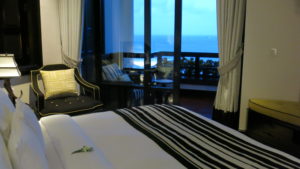
Our room in Heaven, Sun Peninsula, Danang.
And it turned out, Heaven is great place to monkey around.
I mean literally.
And one of them was interested in a melange à trois – but Clint slammed the deck door on the little fella before he could enter our suite. (He grimaced at our lack of hospitality, a toothy monkey sneer.)
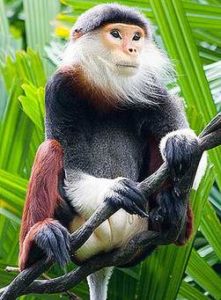
A douc langur wanted to join us for cocktails.
Our would-be BFF was one of the rare, red-shanked douc langurs, about 370 of which inhabit the lush forests of Monkey Mountain, also home to lorises and macaques.
Here’s a link to a virtual tour of the place.
Brace yourself.
But Heaven had to wait: the Danang chapter of our Vietnam story started before we got to the hotel, about 1600 years ago, with the Cham Empire and a tour of the Museum of Cham Sculpture, one of the city’s highlights.
Tru (as we were instructed to call our guide) gave us a rundown on a culture that had occupied Vietnam from the 2nd century AD until its downfall in 1832. Today, the Malayo-Polynesian-speaking Cham, one of 54 ethnic groups inhabiting the country and descendants of the rulers of the South China Sea, plant rice and are known for their pottery. However, the Cham in Vietnam now numbers only about 200,000, down from about 3 million during the golden years, the 8th – 10th centuries, when many of the sensuous sandstone and marble sculptures at the museum, about 300 pieces in all, were created.
The Cham took up Hinduism early, likely converted by Indian merchants, and blended its practices with their traditional beliefs. Among the most spectacular pieces on site: the graceful Dancing Girl of Tra Kieu; busts of the Hindu gods Vishnu, Shiva, and Brahma and their celestial mounts; carvings of all the scenes from the epic “Ramayana.”
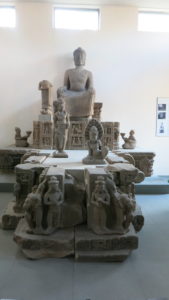
The Cham Buddha
Perhaps the most startling work is a ginormous statue of a Buddha-like figure – with the visage of a Cham king, his proud face with negroid features, including curly hair.
All the sculptures in this gem of a museum date from the 7th – 13th centuries; all were recovered from Cham sites including Tra Kieu, the first Champa capital. Some were from My Son, a former archeological treasure trove, blown to near-smitterines during the war.
Our second day in Central Vietnam was spent in Hoi An, an important trading port from the 16th – 18th century, which attracted traders from China, Japan, and Europe.
In 1999, Hoi An was designated a UNESCO World Heritage Site. And thanks to Tru, we saw it all: Chinese pagodas, ornate community halls, family shrines, still-active old homes boasting eight generations of occupants, a good market, and the famous Japanese Covered Bridge.
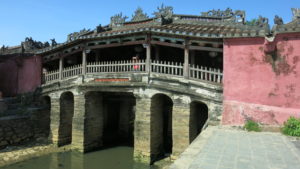
Japanese Covered Bridge
Lunch at the Tam Tam Cafe, housed in a charming old French building since 1996, serves authentic local delicacies such as the “White Rose,” translucent rice dumplings, an Hoian specialty, delicate and delicious.
Can you spell elastic waistbands?
And while we are on the subject, we had two pair of leggings made by a local tailor near the lantern place in the Hoi An Artcraft Manufacturing Workshop complex in under two hours.
We are also bringing home the two lanterns we were taught how to make.
The good news about Hoi An is all the rich history – and the fact no cars are allowed; scooters only certain times of day. The bad: the whole town is for sale. And the “ask” punctuates every tour through every historic site.
Back at the Intercontinental, the grand finale of our two days at the resort was dinner at Ma Maison 1888, one of three first-rate restaurants on the property.
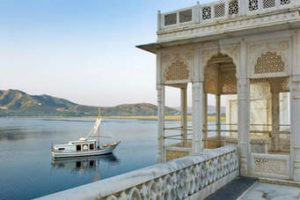
Ma Maison, exterior
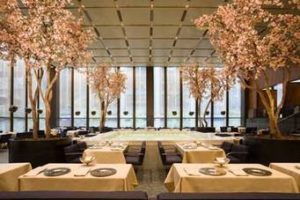
Ma Maison, interior of one of the room.
Ma Maison is first restaurant in Vietnam to feature a Michelin-starred chef. After three successful years working with the legendary chef Michel Roux; his successor, the equally talented Pierre Gagnaire.
Top 10 in the World’s Best New Restaurants 2016 by CNN, this truly special restaurant was designed with an antique French mansion in mind; each dining area with its own intimate niche reflecting a different period.
It was late so we decided to eat light.
Our deconstructed tomato soup appetizer served with smoked eggplant caviar with Vietnamese black pepper, a tomato jelly marinade, prawns with saté and tuna tartar with ratatouille, made our eyes smile and our taste buds applaud. Ditto the main course: sole fillet meuniere with spinach veloute, parmesan grilled leek, razor clams flavored with parsley, gratin basmati rice and green curry.
Service throughout was smooth and slick, but felt laidback.
A peerless experience at a peerless watering-hole.
We were sad to leave Heaven, but it was on to Saigon, aka, Ho Chi Minh City (the official name, but not the name used by most residents in casual conversation).
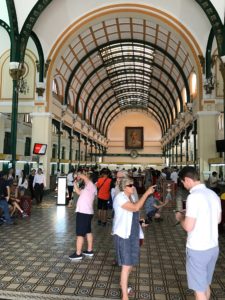
A portrait of Ho Chi Minh presides over the Colonial-era General Post Office.
For us Saigon is a way station. Not much more. Today we leave for a seven-day float on a boat up the Mekong River all the way to Cambodia.
The largest city in Vietnam – population 7 million – Saigon is much like Paris: its residents listen to pop music and drink wine. High-rise hotels, shopping malls, brand-name boutiques, and chic restaurants, are cheek-to-jowl with ancient pagodas and colonial buildings developed by the French, who arrived in 1858. In fact, Saigon was once known as the “Paris of the Orient.”
In rapid succession, the French built the original Presidential Palace in 1868. When that was bombed in 1962, the new “Reunification Palace” was put up in its place.
In 1877, the French put up a variation on the theme of Notre Dame, though much less grand.
In 1886, the General Post Office went up, with its arched ceiling in the Roman tradition, Uncle Ho presiding over the crowds.
Check.
Check.
And check.
We saw them all in a quick survey of the city.
But worth noting is the fact the beautiful post office is now flanked by a MacDonald’s on one side; a Dunkin’ Doughnuts on the other.
One of the tree-lined, main thoroughfares is lined with top-of-the-line boutiques such as Hermes and Versace. Also, count them, three huge, nondescript structures housing malls surround City Hall, another graceful colonial structure.
We even saw a few Rolls Royces (including a gorgeous new Corniche) tooling around town, passing vendors in traditional threads manning carts selling basics like coconuts.
It seems progress in what centuries ago was a former Khmer trading post is a kaleidoscope: turn the dial and different images dominate the evolving landscape.


Sorry, the comment form is closed at this time.